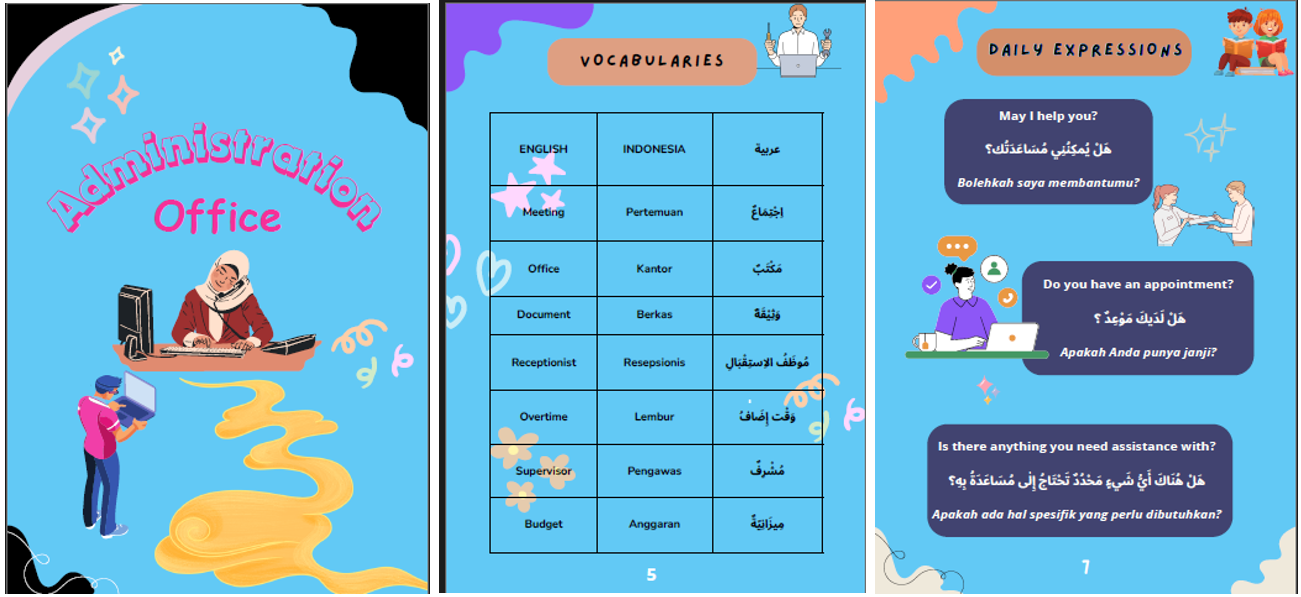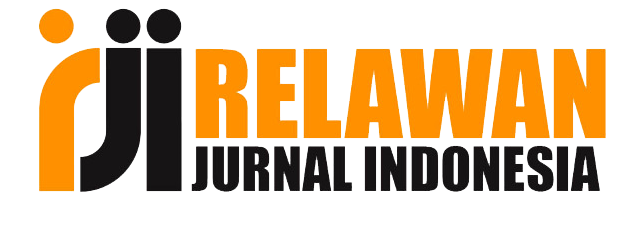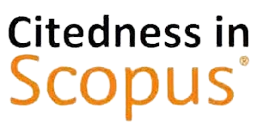Developing bilingual expressions pocketbook for secondary students at Assalafiyah Language Center (ALC)
DOI:
https://doi.org/10.33474/j-reall.v5i1.21444Keywords:
Assalafiyah language center (ALC), bilingual expressions, material development, pocketbookAbstract
The objective of this research was to develop bilingual expressions pocketbook. This research used the type of research and development (RnD) that applied the ADDIE model, which employed five steps, including analysis, design, development, implementation, and evaluation. The product of the research was bilingual expressions pocketbook. The contents of the pocketbook consist of a cover, vocabularies of each topic, and the expressions of each topic. This research was conducted in ALC’s Secondary Students at Assalafiyah, which contained 27 students. In collecting data, the researchers employed some techniques like interviews, questionnaires, tests, and documentation. The result of this research showed that the validation result from the material expert was an average of 3.5. It was categorized as very good. The validation result from the media expert was average, which is 3.6. It was categorized as very good. Therefore, it can be concluded that developing bilingual expressions pocketbook is appropriate to be implemented at ALC. Also, the development of a bilingual expressions pocketbook for Secondary Students at Assalafiyah Language Center (ALC) holds significant promise for enhancing language learning and communication skills. The design phase focuses on creating clear and measurable learning objectives, selecting appropriate instructional strategies, and devising assessment methods that cater to the unique bilingual context. The pocketbook provided students with a handy reference for learning and practicing common bilingual expressions. Also, it can increase students’ motivation and engagement in learning vocabularies.
References
Afrianti, N., Ruslan, D., & Yusuf, M. (2021). Implementation of the e-pocket book to improve learning outcomes in economics at Madrasah Aliyah Madinatussalam, Bandar Khalifah Regency, Indonesia. Budapest International Research and Critics in Linguistics and Education (BirLE) Journal, 4(1), 125–131. https://doi.org/10.33258/birle.v4i1.1566
Armelia, D., Prihatin, I., & Susiaty, U. D. (2019). Pengembangan media pocket book berbasis discovery learning terhadap kemampuan pemahaman Matematis. SAP (Susunan Artikel Pendidikan), 3(3), 175–181. https://doi.org/10.30998/sap.v3i3.3586
Herawati, I., Putra, F. G., Masykur, R., & Anwar, C. (2020). Pocket book digital berbasis Etnomatematika sebagai bahan ajar sekolah menengah pertama. Journal of Mathematics Education and Science, 3(1), 29–37. https://doi.org/10.32665/james.v3i1.132
Istianah, I. (2017). Pengembangan pocket book berbantuan geogebra dengan pendekatan PMRI (Pendidikan Matematika Realistik Indonesia) pada Materi Segiempat Kelas VII SMP/Mts. Aksioma, 7(1), 14. https://doi.org/10.26877/aks.v7i1.1406
Kholis, A., & Azmi, U. (2023). A need analysis on developing English interactive multimodal e-book oriented to 21st century skills. Elsya : Journal of English Language Studies, 5(1), 85–106. https://doi.org/10.31849/elsya.v5i1.11804
Kurniati, K., Ervina, V., Ainatasya, N., & Jailani, A. (2024). The efforts of implementing the 21st century learning in English education. Ainara Journal (Jurnal Penelitian Dan PKM Bidang Ilmu Pendidikan), 5(1), 32–35. https://doi.org/10.54371/ainj.v5i1.358
Nabilah, B., Putra, A. P., & Sutansi, S. (2021). Development of digital comic media flipbook with character content mutual respect at the third-grade elementary school. Advances in Social Science, Education and Humanities Research, 601, 18.
Pulatbek, S. (2023). Importance of digital educational technologies in teaching foreign languages. American Journal of Pedagogical and Educational Research, 18, 298–304.
Safrida, S., Tannady, H., Solissa, E. M., Sapulete, H., & Haddar, G. A. (2023). Strategic leadership analysis of school principal to improve learning quality. Jurnal Pendidikan Dan Kewirausahaan, 11(2), 391–399. https://doi.org/10.47668/pkwu.v11i2.741
Sakinah, N. H., Yuliati, L., & Utama, C. (2023). Development mind mapping-based pocket book learning media to improve student learning outcomes. Madrasah: Jurnal Pendidikan Dan Pembelajaran Dasar, 16(1), 86–93. https://doi.org/10.18860/mad.v16i1.22429
Sugiono. (2016). Metode penelitian kuantitatif, kualitatif, dan RnD. Bandung: Alfabeta.
Sule, T. (2024). The teaching of English language education using technology in the 21st century. Journal of Science, Technology & Mathematics Pedagogy, 2(1), 74–86.
Supardi, S. U. S., Leonard, L., Suhendri, H., & Rismurdiyati, R. (2012). Pengaruh media pembelajaran dan minat belajar terhadap hasil belajar Fisika. Formatif: Jurnal Ilmiah Pendidikan MIPA, 2(1), 71–81. https://doi.org/10.30998/formatif.v2i1.86
Tegeh, I. M., ddk. (2014). Model Penelitian Pengembangan. Yogjakarta: Graha Ilmu.
Yulianto, G. (2022). Developing interactive english e-book using Kotobee Author for SMAS Pelita Raya 10th grade students. Journal of English as a Foreign Language Education, 3(1), 38–47.
Zahrah, S. F., & Kholis, A. (2023). Developing Dirasah Islamiyah Materials based on character values for Afkaaruna Islamic School. Syaikhuna: Jurnal Pendidikan Dan Pranata Islam, 14(01), 20–33. https://doi.org/10.58223/syaikhuna.v14i01.6478

Downloads
Published
How to Cite
Issue
Section
License
Copyright (c) 2024 Ulul Azmi, Aminah Aminah, Adhan Kholis

This work is licensed under a Creative Commons Attribution 4.0 International License.
Authors who publish this journal agree to the following terms:
- Authors retain copyright and grant the journal right of first publication with the work simultaneously licensed under a Creative Commons Attribution License that allows others to share the work with an acknowledgement of the work's authorship and initial publication in this journal.
- Authors can separately make additional contractual arrangements for non-exclusive distribution published by the journal (e.g., publish it in a book), with an acknowledgement of its initial publication in this journal.
- Authors are allowed and encouraged to send their work via online (e.g., in the institutional repositories or their website) after published by the journal.





















